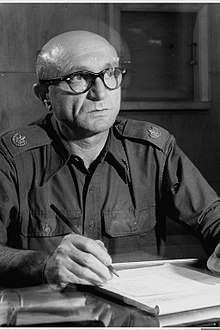Yaakov Dori
Yaakov Dori (Hebrew: יַעֲקֹב דּוֹרִי; October 8, 1899 – January 22, 1973) was the first Chief of Staff of the Israel Defense Forces (IDF). He was also the President of the Technion – Israel Institute of Technology.
Yaakov Dori | |
|---|---|
 | |
| Born | October 8, 1899 Odessa, Russian Empire |
| Died | January 22, 1973 (aged 73) Haifa, Israel |
| Allegiance | |
| Years of service | 1917–1949 |
| Rank | |
| Commands held | Chief of Staff of the Hagana IDF Chief of Staff |
| Battles/wars | World War I 1948 Arab-Israeli War |
Biography
Born in Odessa in the present-day Ukraine (then part of the Russian Empire) as Yakov Dostrovsky (Russian: Яков Достровский), son of Tzvi and Myriam, his family emigrated to Ottoman Palestine following the anti-Jewish pogrom in Odessa in 1905.[1] Upon completing high school at the Hebrew Reali School in Haifa, he enlisted in the Jewish Legion of the British Army during World War I. Following the war he studied engineering at the University of Ghent. When he returned to Palestine in 1926 he joined the Haganah and adopted the underground name of "Dan". In Haganah he was the commander of the Haganah Forces of Haifa.[2]
In 1939, Dori was appointed Chief of Staff of the Haganah, a position he held until 1946. As CoS Haganah it was Yaakov Dori's duty to take the Haganah from a diffuse self-defense organisation to a model army.[2] From 1946 to 1947 he also headed the Palestinian Jewish delegation sent to purchase arms in the United States.
When the IDF was formed, Dori took over as its first Chief of Staff. Yet, despite his good command and organizational skills, he was already suffering from failing health and had difficulty commanding his troops during Israel's War of Independence, so he was forced to rely heavily on his deputy, Yigael Yadin. He completed his term as Chief of Staff on November 9, 1949 and retired from the military. He was succeeded by his deputy, Yadin. Even after his release from the army, however, he continued to wear the officer's pin he was awarded when he first became a second lieutenant.
Upon leaving the IDF, Dori was appointed chairman of the nation's Science Council, attached to the Prime Minister's office. He was later appointed president of the Technion – Israel Institute of Technology in Haifa in 1951, a position he held until 1965.[3] He followed Shlomo Kaplansky, and was followed by Alexander Goldberg.[3]
Yaakov Dori was married since 1929 to the teacher Badana, born Pintov, from the locality Kurenetz in Ukraine.
His son, Yerachmiel Dori, served as commander of the IDF's Engineering Corps. His daughter, Etana Padan, is a biochemist and a professor of microbial ecology at the Hebrew University of Jerusalem. His youngest son, Zvi Dori, was a Chemistry Professor at the Technion and the founder of the first Israeli Science Museum (Technoda). Israel Dostrovsky, physical chemistry and former President of the Weizmann Institute of Science, was his first cousin.[4]
Namesakes
The Israel Defense Forces base at Tel HaShomer, one of the largest in Israel, is named after Ya'akov Dori. A prominent road in Haifa and a street in Beersheba are both named after him.
References
- "Gen Yakov Dori, Haganah Leader - The New York Times". Nytimes.com. 1973-01-30. Retrieved 2020-02-17.
- Gilbert, Martin (1998). Israel: A History. New York: Morrow. p. 101. ISBN 0-688-12362-7.
- "President | Technion - Israel Institute of Technology". Technion. Retrieved 2020-02-17.
- he:אריה דוסטרובסקי
External links
![]()